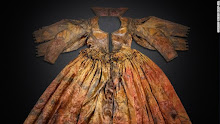In honor of Queen Elizabeth II, and all women who have taken on leadership roles in a man's world (either by birth or by determination and talent), here's an excerpt from my book-in-progress, The Spiritual Mission of a Princess. This section, Femininity As Power, is from the "Dressing for the Illusion" chapter....enjoy.
........................................................................
Several years ago, Nancy Kidwell, who at the time was head costume curator at the Smithsonian, addressed an all-male audience of museum executives regarding the urgency of funding their institutions’ costume departments. Kidwell recalled that she shocked this “sea of gray suits” when she declared: “If you think clothes aren’t important, then try going to work without them!” For women, their clothes are not only “important,” but they inspire a running critique. Any woman, royal or otherwise, who is in the public eye must deal with the criticism and judgment about her “wardrobe”—just check the press coverage on Hillary Clinton or Sarah Palin or Margaret Thatcher or any number of prominent women in politics.
In the culture-shifting 1980s, as women’s roles were changing and more and more women opened their own businesses, ran for political office, entered the workforce once restricted to “men only,” taking on leadership positions in offices and boardrooms, women’s fashions powered-up as well. The man-tailored, hard-edged suits with heavy shoulder pads were like a woman’s “armor” to help her move through a man’s world—Margaret Thatcher comes to mind. And whether it was an intentional feminine gesture or just the Prime Minister’s preference, she always wore skirts.
Of course, Queen Elizabeth always wears skirts—it’s her inherent style. But it’s also a way to stand out in a man’s world, a show of femininity as power. When I returned to work on this long-in-progress book, the third season of Peter Morgan’s television series The Crown premiered in 2019. “I’ve come to realize more than ever,” wrote Sophie Gilbert in The Atlantic, “how the series uses clothing to explore and subvert ideas about power, and what it looks like when a woman wields it.” (This particular season of The Crown was recreating the world of Queen Elizabeth II from the mid-1960s into the late 1970s.) “Typically when women gain access to a man’s world in popular culture, they dress the part, adopting masculine tailoring and fabrics. The Queen is different. Her gender, and her femininity, are intrinsic to the way she governs.” Gilbert describes the opening scene of the first episode as the image of the Queen, played by Olivia Colman, comes into focus “surrounded by a phalanx of men in dark suits. She, by contrast, wears a lilac dress with a love-knot detail over her breastbone, high-heeled black shoes, and pale stockings…. Her authority is such that the men around her bend slightly backward when she enters the room, as if to surrender even the airspace to the head of state.”
 |
| Actresses portraying QEII in "The Crown" television series |
This is why costume designers are key to the appeal and success of films and television programs. Picture Game of Thrones, The Lord of the Rings, or Downton Abbey—their costumes so essential to character development and overall production values. Costume designer Michelle Clapton, who was lured away from her remarkable run with Game of Thrones for most of its season five to create the costumes for the pivotal first season of The Crown, explained: “Correct costuming has its own primary role in enabling the actors to inhabit their characters. I’m the first person they really spend time with; the rehearsals come later. When they put the clothes on, and you get it right, you do see them transform….” Angela Kelly, the real Queen’s senior dresser beginning in the late 1990s and by 2001 her in-house designer, used several techniques to emphasize Queen Elizabeth’s femininity, as well as her authority. Kelly revealed in her book, The Other Side of the Coin: The Queen, the Dresser and the Wardrobe, that she uses striking, vibrant colors for the Queen’s daytime wardrobe, not because they’re the Queen’s favorites, but to “allow her to stand out from the crowd and be visible to the well-wishers who have come to see her.” These are intentional gestures by the Queen and her staff meant to be courteous, diplomatic, and, as Gilbert sees it, a way “to underscore her own authority”—to underscore femininity as power. Something many women are now embracing with a confident stride, again. ~






















No comments:
Post a Comment